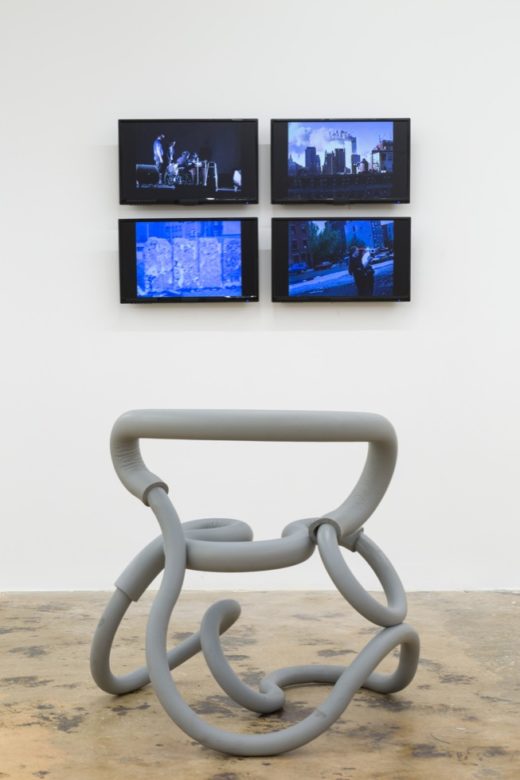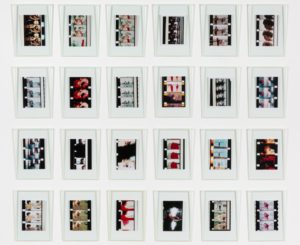A MAGNIFICENT OBSESSION: JONAS MEKAS
MONICA USZEROWICZ

Installation view, Jonas Mekas: Let Me Introduce Myself, Gallery Diet, Miami, with seating by ArandaLasch
The quote above is from Walden, poet and filmmaker Jonas Mekas’s seminal diary film. By the time Walden was released in 1969, the Lithuanian-born Mekas had already made several films and founded the Filmmakers’ Cinematheque, which would grow into the Anthology Film Archives, perhaps the world’s largest archive of avant-garde film. He’d arrived in New York with his brother Adolfas at the age of twenty-seven, after being imprisoned by the Nazis, spending time in a displaced persons camp, and later studying philosophy. Throughout his youth, he’d been guided by what he has referred to as “the muse,” viewing the world through his own singular lens. Mekas has long been associated with contemporaries and friends like Stan Brakhage and Kenneth Anger, but at ninety-three years old and prolific as ever—his website is updated daily with videos—he feels peerless and unprecedented, his poems and work becoming increasingly more beautiful over time.
That bit about the sun never rising—it’s spoken over shots from the train window, the sun bright like a flowering fruit, and it crystallizes the spirit of Walden and of Mekas himself, simplistically alluding to a kind of grandeur. In an ode to Mekas and the film, given its reputation as a gateway to the rest of his oeuvre, Obsolete Media Miami and Ground Control Miami presented a screening of Walden at the Design District’s Palm Court on its six original reels. The screening was planned in conjunction with Let Me Introduce Myself, an exhibition at Gallery Diet featuring Mekas’s work, both early and recent.

Installation view, Jonas Mekas: Let Me Introduce Myself, Gallery Diet, Miami, with seating by Aranda\Lasch
At Diet, The Destruction Quartet (2006), a four-channel video installation, showcases the destruction of September 11th, the dismantling of the Berlin Wall, a fire sculpture by Danius Kesminas, and Nam June Paik destroying a piano, respectively.It’s easy to watch these instances of devastation—one heartbreaking, one healing, two creative—as tributes to the inextricable connection between destruction and creation. It is easier to feel this way when Mekas himself says to you (as he did to me), “Not all destruction is negative.” There is destruction of a different sort, a slow, sad fade, in the images of Elvis displayed nearby, taken at Madison Square Garden during his famed 1972 performance. We see him with a multitude of expressions—Mekas was up close— and for a moment, if we suspend disbelief, it’s unclear if we’re looking at a falling or rising star. Chairs designed by Aranda\ Lasch, from their Railing series, dot the space. Though their form is abstract, made up of one line curling itself into something resembling a seat, they feel sturdy. The romance of Mekas’s work lends the chairs a kind of intrigue that might be reaching other-wise: look, they’re all one loop, like little films.

Jonas Mekas, The Destruction Quartet, 2006. Four-channel video
On the other side of Diet, there are two more photo series: This Side of Paradise, which features the Kennedy family on vacation in Montauk, and To New York With Love. The Kennedy series is showcased as C-prints, each appearing to have been taken from film reels (the image appears multiple times along a negative, as if scooped from the cutting room floor). We see the children cloaked in red towels along the beach, in profile with sand-colored skin and windblown hair, roughhousing in the grass. In To New York With Love, there’s a pinkish self-portrait of a young Mekas, figures in the snow, the profile of a girl who might appear in Walden, too. “The show is called Let Me Introduce Myself,” Mekas explained to me. “So here I am, introducing myself.”

Jonas Mekas, This Side of Paradise, 1999. Chromogenic prints
The screening of Walden might’ve easily been titled Let Me Introduce Myself, as well. Operated by artist William Keddell, a Bolex camera—the same camera used to shoot the film—captured guests posing and dancing in front of a curtain, a delightful little novelty. For all his accomplishments as a master of the American avant-garde (not excluding becoming synonymous with the genre itself), Mekas seems decidedly, unabashedly without motive, and Walden, free as it is from the restraints of formal narrative, is replete with the director’s assertions throughout: “They tell me I should always be searching, but I’m only celebrating what I see.” In one scene, in response to a request to film an underground movie, Mekas and Adolfas head to the woods, where Mekas screams, “Underground movie!” with the Bolex pointed at the forest floor. During a post-screening Q & A session, when asked about different categories of film, Mekas replied, “‘Low-budget,’ ‘under-ground,’ ‘experimental’—it’s meaningless. ‘Independent?’ Spielberg is more independent than Brakhage. Spielberg can do whatever he wants. I’m not independent. I depend on so many things: what I eat, what I see, all my friends. I depend.”

Installation view, Jonas Mekas: Let Me Introduce Myself, Gallery Diet, Miami
In three hours, Walden captures everything upon which Mekas depends, in mostly short snippets, though they are sometimes elongated to whole chapters. At the time of its release, this free-flowing style was groundbreaking in form, but there was no point established in its con-tent other than, perhaps, beauty, or that life is often beautiful. His camera pans— sometimes lovingly, other times in bursts of frenetic, inebriated energy—over boats in a harbor, a cat eating his breakfast crois-sant, a passerby in a blizzard, John Lennon and Yoko Ono enacting their famous bed-in. Prior to the screening, Mekas prepared us: “No tragedy, no suspense. Just images…. It’s a diaristic form of cinema. It’s also a narrative. Any life is a narrative. Day after day, you meet different people. Usually there is no reason. I constructed reality according to my temperament.” There’s the rub: any life is a narrative, and it’s not so important—and every life is a narrative, so it’s deeply import-ant. (Or not.)
The original reels were quite noisy which, as Mekas explained, “was part of the process of projecting. We did not hide the sound.” They mirrored Walden’s soundtrack, an aural landscape of subway clack-clacketing and Mekas’s accordions. Mekas’s camera seems at once quietly observational and in awe of the blossoming life around him, its unwitting flourishes and gentle simplicities, its noise and stillness. A Velvet Underground show—reportedly their first—is filmed in a whoosh. Brakhage wanders through a park. Scenes of a friend’s children at breakfast are overlaid with images of flowers, as if the babies, too, are in bloom. Walden is kaleidoscopic, sometimes quite literally. One segment, captioned “Wendy’s Wedding,” features a wedding reception punctuated by a dizzying strobe light. Wendy’s lace dress is illuminated.

Installation view, Jonas Mekas: Let Me Introduce Myself, Gallery Diet, Miami, with seating by Aranda\Lasch
I spoke to Bruce Posner, an archivist and filmmaker who curated The Unseen Cinema, a twenty-part program showcasing American experimental films, pre-1940s. Mekas allowed Posner to scour his own archives for these works. While attending the School of the Art Institute of Chicago, Brakhage, one of Posner’s professors, screened Walden. “Chicago was really depressing, especially in the winter,” he explains. “I was watching Walden, and all of a sudden, there’s my best friend at Wendy’s wedding.” The friend is Marilyn Gottlieb, an artist who moved in the same circle as Posner. (In a fortuitous twist, the wedding took place at 80 Wooster Street, which would later become the Anthology’s first location.) In the dead of winter, Posner was warmed by Walden. “Proust has his cookie, and Jonas has New York City,” he says. “He forces you to see it right in the moment. Not as it’s happening, but as he sees it.”
It’s true: we’re right there with Mekas—but we trust and indulge in his vision. It’s difficult to explain why snippets of another person’s life feel so poignant to the viewer. Perhaps it speaks to the innate empathy of documenting humanity with such blithe tenderness. During the Q & A, one gentleman politely asked, “Why is it important to document life?” Mekas responded to this (and all the questions), in a manner similar to Walden’s movement: terse and then warm, short and then, after a pause, meandering. “It is not important at all to document life,” he said abruptly. And then: “But we do that. It’s obsession. It’s magnificent obsession. In a moment, everything we went through falls into dust.” Life is meaningful—until, of course, it isn’t.
Monica Uszerowicz is a writer, photographer, and the film and performing arts editor for the Miami Rail.










